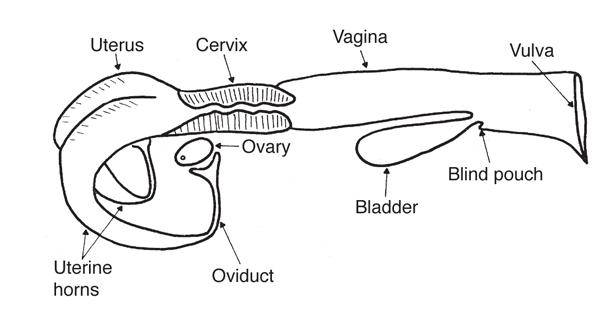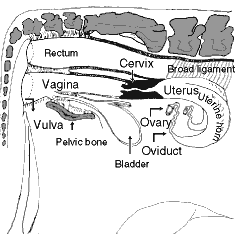
The reproductive tract of a cow is located beneath the rectum—the last segment of the large intestine. Most parts of the reproductive tract can be examined indirectly when an arm is extended into the rectum (rectal palpation):
- The cervix can be manipulated during artificial insemination.
- The follicles or corpus luteum (CL) may be identified on the ovaries.
- The presence of a growing embryo in the uterus can be detected.
Vagina
The vagina is a flattened tube, normally about 30 cm long. It is the site of semen deposition during natural service. The vagina serves as a passageway for the instruments used for artificial insemination and for the emergence of the calf at the time of birth.
Cervix
The cervix is a strong muscle about 10 cm in length and 2.5 to 5 cm in diameter. It is pierced in its centre by a narrow canal. The canal is usually closed (and sealed during pregnancy) except during heat and at birth. The cervix is a very effective "control gate" that prevents any foreign material from invading the uterus and, in effect, isolates it from the outside world.
Uterus
The uterus is the part of the reproductive tract where the developing calf is carried. In a non-pregnant cow, the body of the uterus is less than five centimetres long and has left and right horns that curve like those of a ram. The uterus is a muscular organ capable of enormous expansion to accommodate a growing calf. By the end of a pregnancy, the uterus contains a calf of 35 to 40 kg, 20 to 30 kg of fluid, and five kg of placental tissue (afterbirth). After calving, it takes about 40 days for the uterus and other parts of the reproductive tract to regain their non-pregnant size (this process is called involution).
Oviducts
The oviducts are the two convoluted tubes that join each of the uterine horns to one of the cow's two ovaries; they are more than 20 cm in length and only 0.6 cm in diameter. The end of each oviduct opens into a funnel-shaped structure (infundibulum); this structure collects the egg that is ejected from the ovary during the heat. Fertilization, or the union of the egg and a spermatozoon, occurs in the oviduct. The embryo stays in the oviduct for three or four days before moving into the uterus. This period of time is necessary for the uterus to prepare itself to receive a growing embryo.
Ovaries
In a non-pregnant cow, the ovaries are oval (shaped like an egg), about four to six cm in length and two to four cm in diameter.
One of two structures predominates at the surface of an ovary: either a follicle containing a maturing egg, or a corpus luteum (yellow body) which grows from what remains of a follicle after the egg has been expelled (ovulation).

Egg or Ovum
In contrast to all other cells in the body, each egg contains only one copy of the genetic information contained in the chromosomes. Eggs are found in the ovary before birth, but the maturation of the eggs begins with sexual maturity at puberty (12 to 14 month of age) and the onset of heat cycles.
The Heat Cycle
The heat cycle is the interval (21 days average length) between two heats. A heat, or oestrus, lasts six to 30 hours and is the period of sexual receptivity (Day 1 of a cycle).
Follicular Phase
Toward the end of a heat cycle when an egg reaches maturity, it is enveloped in a series of coating cells and is surrounded by nutritive substances. The entire structure is called a follicle and it secretes estrogen, a hormone that changes the behaviour of the cow in heat. It is only during a heat that a cow allows herself to be mounted by a bull or other cows. During heat, the egg and the follicle reach the final stages of maturation.
At ovulation (12 hours after the end of signs of heat), the follicle "explodes," the egg is propelled into the oviduct and the remaining cells on the ovary begin to form a new structure called a corpus luteum. The corpus luteum secretes a hormone called progesterone that prevents the complete growth of follicles and is necessary to maintain pregnancy.
Corpus Luteal Phase
The complete development of a corpus luteum takes about three days (Days 2 to 5 of a cycle). Although some follicles start to grow on Day 1 of the cycle, the progesterone secreted by an active corpus luteum prevents them from maturing and they degenerate. On Days 16 to 18 of a cycle, if the uterus has not detected the presence of an embryo, it will send a hormonal signal (prostaglandins) that causes the corpus luteum to regress. This regression removes the inhibition of the final phases of follicular growth and allows a dominant follicle to complete its maturation. This leads to a new heat and the beginning of a new cycle.
The uterus, oviducts and ovaries are suspended in the body cavity by a broad ligament. The position of this ligament permits the uterus to accommodate a growing foetus.
